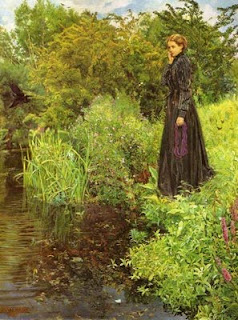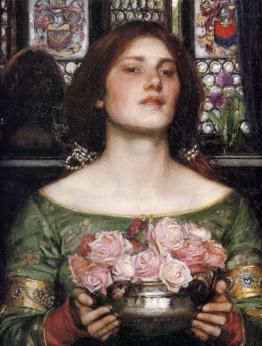"... The Boer War is her back-story ... her motivation, the reason for her state of mind. ... But at the same time, clearly, we're to feel a great rupture and estrangement between those words, The Boer War, and the scene before us. And this distance can stand for and stress the various other distances - geographic, experiential - that the work evokes.
There is the distance between peace and war. There is the distance between the green English countryside and the dusty South African veldt. There is the distance between the woman and the man who was absent far away and is now absolutely dead and gone. There is the distance between the woman, with her mind fixed on loss and death, and the burgeoning natural world around her ..."
There is the distance between peace and war. There is the distance between the green English countryside and the dusty South African veldt. There is the distance between the woman and the man who was absent far away and is now absolutely dead and gone. There is the distance between the woman, with her mind fixed on loss and death, and the burgeoning natural world around her ..."
 The Boer War, 1901
The Boer War, 1901"The classic pre-Raphaelite manner of Byam Shaw's painting, with its manic eye for the proliferating detail of nature, contributes to this effect. You can see it as how the woman herself sees her surroundings. Shock and grief can cause the mind to become blankly transfixed by the minutiae of the physical world, seeking something clear and particular to hold on to - as the narrator in Tennyson's poem 'Maud' focuses on a tiny sea shell after his world has fallen in.
Or again, the way the title, 'The Boer War', fails to "mean" the picture is like the way those words might become a malignantly empty phrase in the woman's mind ... Reading things into it? Yes, exactly. That's what this kind of picture, this word-image-juxtaposition, invites you to do. Reading things in, letting scene and title interact in the mind, is the way it works. In more than one way, Byam Shaw's painting about a remote Imperial war has a rather contemporary feeling." - Tom Lubbock
The painting's subtitle: "Last summer green things were greener, brambles fewer, the blue sky bluer" - is an extract from A Bird Song by Christina Rossetti.
Or again, the way the title, 'The Boer War', fails to "mean" the picture is like the way those words might become a malignantly empty phrase in the woman's mind ... Reading things into it? Yes, exactly. That's what this kind of picture, this word-image-juxtaposition, invites you to do. Reading things in, letting scene and title interact in the mind, is the way it works. In more than one way, Byam Shaw's painting about a remote Imperial war has a rather contemporary feeling." - Tom Lubbock
The painting's subtitle: "Last summer green things were greener, brambles fewer, the blue sky bluer" - is an extract from A Bird Song by Christina Rossetti.


























No comments:
Post a Comment